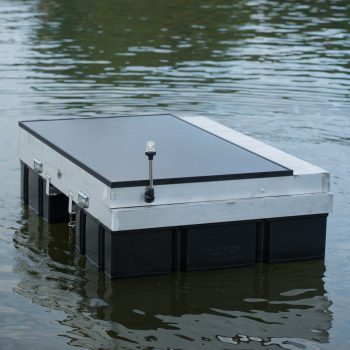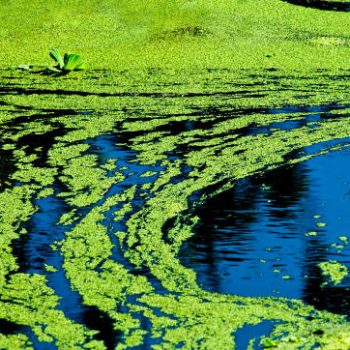Algae and Biofilm: a potentially dangerous problem:
Algae and biofilm in water are more than just a smelly scourge. They can be a harbinger of much larger concerns that can be unsightly, and, at worst, affect animals, humans, and property.
What are the risks of untreated algae and biofilm in water?
Learn why algae and biofilm can be difficult to treat and completely eradicate.
Often referred to as pond scum or seaweed, algae is neither, but that doesn’t make it less of a problem.
When open water is involved, you’ll likely encounter this unsightly and costly maintenance nuisance. It’s ever-present in our water systems, as well as ponds, lakes, treatment facilities, swimming pools, industrial tanks, cooling towers and lagoons.
More than just a smelly scourge, the presence of algae can be the harbinger of much larger concerns. These include:
- Increased risk of toxicity of recreational water to people, pets, and other animals.
- Toxicity of farm pond water to livestock.
- pH imbalance due to the rigorous treatment methods needed to regulated algae growth.
- Fish kills due to algae die off for hatcheries, lakes, and private ponds.
- Boat propeller entanglement.
- Swimming safety concerns.
- Increased water treatment operating costs for clarification, filtration, taste, and odor treatment. Some algae can generate organic chemicals such as Geosmin and Methyl Isoborneol (MIB) that produce sewer smells. You can detect MIB smell at five parts per trillion in air.
- Reduced property values due to the sight and smell of algae.
- Financial losses due to tourism and business community impact.
- Increased risk of red tides, where polluted rivers and streams meet tidal and marine waters.
Algae, on its own, can be a rather vexing issue. But it often is accompanied with the growth of biofilm, that slimy growth of bacteria that tends to cling to solid surfaces present in water.
Added concerns from biofilm growth in water include:
- Increased maintenance and cleaning costs.
- Potential generation of carcinogenic chlorinated byproducts such as tri-halo methanes (THMs) and halo acetic acids (HAAs) which, if not controlled, can lead to heavy fines and penalties.
- Promotion of other bio-growth, such as barnacles, mussels, oysters, etc., which can foul pumping operations.
- Heat exchanger fouling and loss of cooling efficiency, both of which can drives up operating costs.
- Boat hull fouling, which increases drag and fuel costs.
- Under-deposit corrosion in piping and boat surfaces.
- Manganese precipitation, notable for a change of color on the surface of heated water.
What causes Harmful Algae Blooms (HABs)?
Learn more about the phosphate and nitrate diet of HABs.
Algae is a hungry organism that likes to feast on phosphates and nitrates — two common pollutants that can commonly be found in detergents, fertilizers and many consumables, including carbonated beverages. These pollutants don’t simply arrive out of thin air. They are a result of effluent from sewage and septic systems, runoff from over fertilized lawns, leaf and grass clippings blown into ponds and lakes, and even agricultural farming using non-contour plowing methods.
The most concerning HABs occur during peak summer months, when the heating of the day provides enough of a catalyst to warm ponds and lakes top to bottom, activating anaerobic bacteria in the muck layers. These bacteria undergo a metamorphosis, causing a significant amount of phosphates stored in the muck to be released as the organic content is consumed.
Blue-green algae have a particular affinity for warm weather — they are genetically suited to thrive in the heat of summer by using gas vesicles to regulate their buoyancy control. This allows them to sink down to the lower water levels and dine on the plentiful phosphates being released from the muck.
Treating algae with chemicals can backfire
Humans have attempted to combat algal blooms for hundreds of years -- using methods that have either been limited in success or rife in harmful side effects.
A common treatment of algae in water is the use of chemicals. While chemicals can be effective in the removal of algae, they can be expensive and create harmful risks, both for people and water ecosystems.. Copper sulfate, the most common chemical used to treat algae, has been flagged a class 1 highly toxic chemical by the EPA. One of the negative effects of chemicals such as copper sulfate is the creation of a sterile bottom that kills essential nutrients, as well as good bacteria depended upon by fish and other forms of aquatic life.The use of chemicals can also lead to corrosion of steel, iron, and galvanized pipes.
Of course, just leaving the algae in the water is a non-starter: When left unchecked, algal blooms can wreak havoc. Algae’s presence in wastewater treatment facilities, notably lagoons, can lead to a systemic starvation of needed oxygen supplies.
Combined with warmer temperatures and nutrients such as nitrogen, the reduction of dissolved oxygen in the water can stress local aquatic life and can lead to even more rampant algal growth and HABs, producing cyanotoxins.
What are the risks when your HABs are left unchecked?
The risks from proliferating algal blooms include:
- Airborne contaminants: Algae blooms can release material into the atmosphere which can have impacts on people breathing it in. Particles can be carried hundreds to thousands of miles by air.
- Untreated algae can create an ecological imbalance, creating a habitat for invasive species that kill off good bacteria and other forms of water life. Excessive amounts of nitrogen and phosphorus in water leads to algae growing faster that our ecosystems can handle. Water quality is negatively impacted, and decreased oxygen levels become harmful, if not fatal, to fish.
- Untreated algae can create off-limits conditions to outdoor enthusiasts such as swimmers, boaters, and anglers. It is becoming increasingly common to see lakes and ponds closed to recreationists because of algae blooms. This not only spoils it for the sportsperson, but has a negative effect on local economies that depend on visitors.
- The presence of algae and biofilm in our water can turn what would normally be a beautiful blue body of water into a body of soupy green muck. What was beautiful becomes an eye sore and one that might emit unpleasant orders and pose a significant health threat to people and animals.
- With poor aesthetics and the health and environmental risks posed by algae, nearby properties can become less desirable, and property values can fall sharply.
- Golf courses can be adversely impacted by algae growth in lakes and ponds. Not only does algae impact the local ecosystem, it negatively impacts the experience of patrons and members. It also poses a health and safety risk for maintenance crews who have to contend with both the algae and the related treatment methods, which frequently can include the use of chemicals.
- Biofouling, the microbial contamination caused by biofilms found in water, can harbor human pathogens that threaten public health and cause environmental and property damage. This also leads to the introduction of non-indigenous species, such as Zebra mussels, which feed off biofilm and can outcompete native species. Boats being transported from a contaminated lake or even the emptying of ballast water from boats and ships can carry these harmful biofilms.
One of the problems facing municipalities faced with algae problems, real or not, is public sentiment. The electorate has become very vocal about water quality, and rightfully so. Officials are extremely sensitive to their community’s perception of local water quality. Off odors and taste can trigger quick responses from the public demanding to know if their water is safe. Of course, many of the chemicals used in algae treatment have a similar stigma in the public consciousness.
WaterIQ Technologies™ is ready for your algae and biofilm challenges
Ultrasonic technology from WaterIQ Technologies leverages science and sustainability to put an end to out-of-control algae and biofilm growth. This technology is, helping return water ecosystems to their natural state using a sonic alternative to harmful chemicals. . Ultrasound waves disrupt algae cells, causing them to lose buoyancy, sink and die—all without harming other aquatic life. The waves also inhibit biofilm from attaching to surfaces and growing. You do not need to use dangerous chemicals to deal with these problems—WaterIQ Technologies products can help you control algae and biofilm safely, efficiently and in an environmentally friendly way.
Read this quick ultrasound technology overview so you’ll understand just how ultrasound technology works to control algae and biofilm problems, and what features to look for to treat your application.
Algae and biofilm problems don’t go away by themselves. Let WaterIQ Technologies can help you find the best solution to your water purity challenges. Take a look at our case studies and other information in our Resources section, and feel free to contact us at any time for answers to your questions.
WaterIQ Technologies is ready for your algae and biofilm challenges
Algae and biofilm problems don’t go away by themselves. Let WaterIQ Technologies help you find the best solution to your water purity challenges. Take a look at our case studies and other information in our Resources section, and feel free to contact us at any time for answers to your questions.


